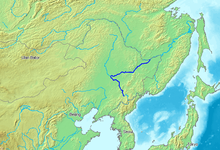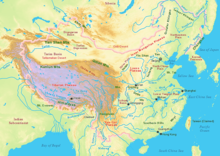
Back Llanura del nordeste de China AST Сунляо Byelorussian Сунляо Bulgarian Mandžuská nížina Czech Nordostchinesische Ebene German Nordorienta Ĉina Ebenaĵo Esperanto Llanura del Noreste de China Spanish Mandžuuria tasandik Estonian Mantšurian tasanko Finnish מישור צפון-מזרח סין HE


The Northeast China Plain (simplified Chinese: 东北平原; traditional Chinese: 東北平原; pinyin: Dōngběi Píngyuán), commonly known as Songliao Plain or the Manchurian Plain or just the Northeast Plain, is located in Northeast China, historically also known as Manchuria. It lies between the Greater and Lesser Khingan and Changbai mountains, ending at the coast at Liaodong Bay in the Bohai Sea.[1] Covering 350,000 km2, it is China's largest plain, with an elevation of lower than 200 meters, and less than 100 meters to the southwest.[2] The Songhua, Nen, and Liao rivers run through it.[3] The Manchurian Plain of Asia is the other name of the Amur valley.[4]
The Northeast Plain includes Songnen Plain in the north, Liaohe Plain in the south, and Sanjiang Plain in the northeast. The Songnen plain was formed by the Songhua and alluvial soils from the Nen. The Liaohe plain, located in the hilly areas near Changchun, was created by the separation of watersheds of the Songhua and Liaohe, which are collectively known as the Liaohe plain. The Sanjiang plain, at the confluence of the Sungari, Amur, and Ussuri rivers,[4] was originally a swamp known as the "Great Northern Wilderness", becoming a food-producing area after reclamation. The original wetland area of the Sanjiang plain has been greatly reduced.
- ^ China: a Country Study, Library of Congress Country Studies, 1987. Retrieved 12-5-2019.
- ^ Great Soviet Encyclopedia, Northeastern Plain.
- ^ china.org.cn. CHINA FACTS & FIGURES 2002. Retrieved 12-5-2019.
- ^ a b Encyclopedia Britannica. Northeast Plain. Retrieved 12-5-2019.